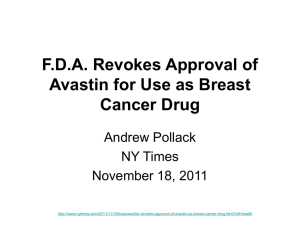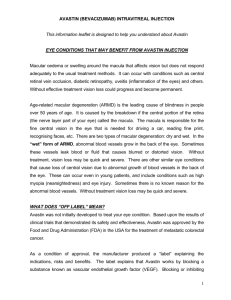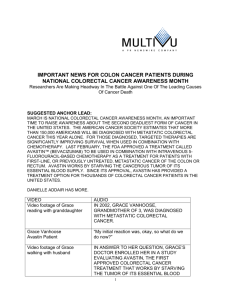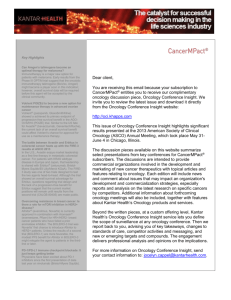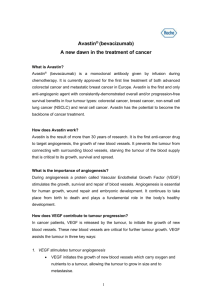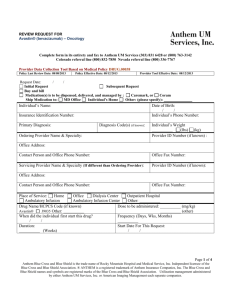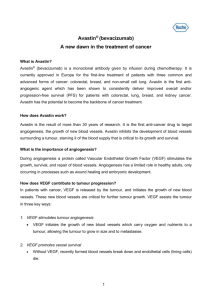Ralph W
advertisement
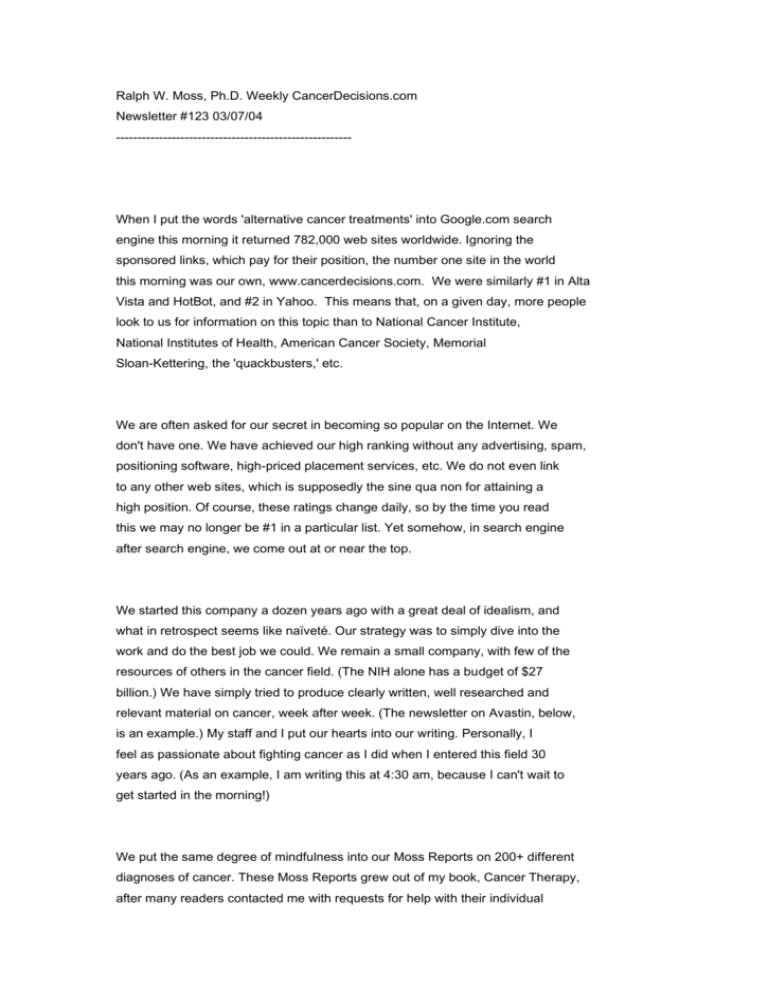
Ralph W. Moss, Ph.D. Weekly CancerDecisions.com Newsletter #123 03/07/04 ------------------------------------------------------- When I put the words 'alternative cancer treatments' into Google.com search engine this morning it returned 782,000 web sites worldwide. Ignoring the sponsored links, which pay for their position, the number one site in the world this morning was our own, www.cancerdecisions.com. We were similarly #1 in Alta Vista and HotBot, and #2 in Yahoo. This means that, on a given day, more people look to us for information on this topic than to National Cancer Institute, National Institutes of Health, American Cancer Society, Memorial Sloan-Kettering, the 'quackbusters,' etc. We are often asked for our secret in becoming so popular on the Internet. We don't have one. We have achieved our high ranking without any advertising, spam, positioning software, high-priced placement services, etc. We do not even link to any other web sites, which is supposedly the sine qua non for attaining a high position. Of course, these ratings change daily, so by the time you read this we may no longer be #1 in a particular list. Yet somehow, in search engine after search engine, we come out at or near the top. We started this company a dozen years ago with a great deal of idealism, and what in retrospect seems like naïveté. Our strategy was to simply dive into the work and do the best job we could. We remain a small company, with few of the resources of others in the cancer field. (The NIH alone has a budget of $27 billion.) We have simply tried to produce clearly written, well researched and relevant material on cancer, week after week. (The newsletter on Avastin, below, is an example.) My staff and I put our hearts into our writing. Personally, I feel as passionate about fighting cancer as I did when I entered this field 30 years ago. (As an example, I am writing this at 4:30 am, because I can't wait to get started in the morning!) We put the same degree of mindfulness into our Moss Reports on 200+ different diagnoses of cancer. These Moss Reports grew out of my book, Cancer Therapy, after many readers contacted me with requests for help with their individual problems. The basic idea was to provide cancer patients with a carefully considered review of their treatment options, conventional and alternative. Many people have told us that these reports (which cost $297) have been extremely helpful in clarifying their options. They usually reveal new possibilities and shorten the time needed to learn about this vast topic. The Reports are not compilations of other peoples' writings. They are fresh, original material written by me and my research staff. I also offer phone consultations and help in researching specific questions. If you want to learn more about what we offer, please go to our website, www.cancerdecisions.com, where you can order your report online. Or call our office at 800-980-1234 anytime. (The phone is answered by a live human being around the clock.) When calling from outside the US, please use 814-238-3367. Let us know how we can help you. FDA APPROVES AVASTIN On the heels of its recent approval of Erbitux, the US Food and Drug Administration (FDA) has now approved another drug for the treatment of advanced colorectal cancer. This new drug is Avastin, manufactured by Genentech, Inc., South San Francisco, Calif. Avastin is one of a class of drugs called angiogenesis inhibitors. It works by targeting and inhibiting the functioning of a natural protein called 'vascular endothelial growth factor' (VEGF), which stimulates new blood vessel formation. When bound by Avastin, VEGF can no longer stimulate the growth of blood vessels, thus denying tumors the blood, oxygen and other nutrients they need for growth. Avastin, whose generic name is bevacizumab, has been approved as a first-line treatment for patients with metastatic colorectal cancer. It thus will be highly competitive with Erbitux, which was recently approved for use as a last-ditch therapy in advanced stages of this disease. Both Erbitux and Avastin are genetically engineered versions of a mouse antibody that contains both human and mouse components. Avastin is the first angiogenesis inhibitor ever approved to treat cancer. As such, it has generated a great deal of hope and excitement. It appears to work in accordance with a theory put forward 30 years ago by Prof. Judah Folkman of Harvard, who suggested that by stopping the growth of new blood vessels one could halt the growth of cancer. The FDA approved Avastin based on the results of a randomized, double-blind clinical trial of more than 800 patients with metastatic colorectal cancer. Avastin was found to extend colorectal cancer patients' lives by 4.7 months, when given intravenously along with a standard chemotherapy regimen known as IFL (aka the 'Saltz regimen'). IFL includes the already-approved drugs irinotecan (Camptosar or CPT 11), 5-fluorouracil (5FU) and leucovorin. Patients who received IFL alone lived on average 15.6 months. Those who also got Avastin survived on average 20.3 months. The average time before tumors started re-growing, or new tumors appeared, was four months longer in patients given Avastin than in patients who received IFL alone. The overall response rate to the IFL/Avastin treatment was 45 percent compared to 35 percent for the control arm of the trial. There is no mention of any complete responses or cures. (A complete response is defined as the disappearance of all measurable tumors for one month or more.) These positive results with Avastin came as a surprise. Just last year, its track record did not look particularly promising. A 2003 clinical trial at the National Cancer Institute, for example, found that there were no significant differences in overall survival between those getting high-dose Avastin, low-dose Avastin, and no supplemental Avastin at all (Yang 2003). Yet Mark B. McClellan, M.D., Ph.D, the departing FDA Commissioner, apparently sees things in a very different light. Both Avastin and Erbitux have "significantly improved the armamentarium for fighting this disease," he claimed. "These medical achievements [are]...making a real difference in the lives of cancer patients" (FDA News, 2004). Serious Side Effects Angiogenesis inhibitors have been widely hailed as a benign form of treatment. According to an interview with Dr. Folkman, "…unlike chemotherapy, angiogenesis inhibitors will be used on a long-term basis for two important reasons: they will not generate drug resistance and they will be non-toxic" (Folkman, 2004). However, in the current trials treatment with Avastin plus chemotherapy had many adverse consequences. At Genentech's website, www.avastin.com, the company states that "administration can result in the development of gastrointestinal perforation as well as wound dehiscence, in some instances resulting in fatality." (Dehiscence is the rupture or splitting open of a surgical wound, or of an organ or structure.) With Avastin, such perforations are sometimes associated with the formation of abscesses in the bowel, which may sometimes be accompanied by internal bleeding. The incidence of this type of severe adverse event was 2 percent. High Blood Pressure Crises The Genentech website further states that "serious, and in some cases fatal, hemoptysis has occurred in patients with non-small cell lung cancer treated with chemotherapy and Avastin." Hemoptysis is the expectoration of blood or of blood-streaked sputum from the larynx, trachea, bronchi, or lungs. "In a small study," it continues, "the incidence of serious or fatal hemoptysis was 31 percent in patients with squamous histology (the microscopic structure of tissues, ed.) and 4 percent in patients with adenocarcinoma receiving Avastin…." In the clinical trials just announced the treatment was associated with high blood pressure in 60 percent of patients. In 7 percent this hypertension was severe enough to constitute a crisis (with a cuff reading of more than 200/110 mmHg), requiring emergency treatment. Despite palliative treatment, however, the hypertension was found to be long-lasting in a majority of cases. "Four months after discontinuation of therapy, persistent hypertension was present in 18 of 26 patients that received bolus-IFL plus Avastin and 8 of 10 patients that received bolus-IFL plus placebo." (A 'bolus' is a single relatively large dose of a drug.) In other words, the company is suggesting that severe hypertension is caused more by the IFL than by Avastin itself. There have indeed been serious concerns in the past over the toxicity of IFL. In 2001, for instance, two prominent clinical trials were suspended because the death rate on the Saltz regimen (i.e., IFL) was elevated (Goldberg 2001). Another serious danger with the Avastin/IFL regimen is congestive heart failure (CHF), which was reported in 22 of 1,032 (2 percent) patients receiving Avastin in these trials. CHF occurred in an even higher percentage - six out of 44 (14 percent) - of patients who received Avastin along with the common anthracycline drugs, such as Daunorubicin, Doxorubicin (Adriamycin), Epirubicin, and Idarubicin, all of which are known to have cardiotoxic effects in their own right. Congestive heart failure occurred in 13 of 299 (4 percent) of patients who had previously received anthracyclines and/or left chest wall irradiation. Nephrotic Syndrome Severe damage to the kidneys, resulting in nephrotic syndrome, occurred in five of 1,032 (0.5 percent) patients receiving Avastin in Genentech-sponsored studies. One patient died and another required dialysis. No patient had normalization of 24-hour urinary protein levels following discontinuation of Avastin. Other side-effects included weakness, abdominal pain, headache, diarrhea, nausea, vomiting, anorexia (wasting), mouth sores, constipation, upper respiratory infection, nosebleeds, difficulty breathing, peeling skin, and protein in the urine. (The company does not provide any statistics concerning the frequency of these side effects.) While the influence of Avastin on overall survival appears to be similar in older, as compared to younger, patients, Avastin may give rise to more serious side effects in patients over the age of 65 than it does in younger patients. According to the company website, among the severe adverse events that occurred at a higher rate in the elderly were asthenia (i.e., weakness), sepsis (infection of the blood), thrombophlebitis (inflammation of a vein associated with clot formation), hypertension, hypotension (low blood pressure), myocardial infarction (heart attacks), congestive heart failure, diarrhea, constipation, gastrointestinal hemorrhage, anorexia (wasting syndrome), leukopenia (loss of white blood cells), anemia, dehydration, hypokalemia (lowered blood potassium), and hyponatremia (lowered blood sodium). In addition, less severe side effects such as indigestion, edema, nosebleeds, increased coughing, and voice alteration were also seen. Paucity of Data Traditionally, publication has been considered an essential part of the scientific method. Approval of a new drug or the adoption of a new treatment has until recently been based on the outcome of rigorously designed clinical trials, the results of which had to be submitted for publication in peer-reviewed journals. Once results were published in this way, other scientists had an opportunity to attempt to reproduce them. Only when this protracted process had been completed was a treatment considered ready for final regulatory approval by the Food and Drug Administration. Today, however, new clinical information is frequently hoarded and closely guarded as a trade secret. The data I have cited above comes not from peer-reviewed studies in medical journals, but from the websites of the FDA and Genentech, the manufacturer of the drug Avastin. No individual authors are listed, no publication citations given. If you try to find independent data on Avastin you will probably be disappointed, as I was. For instance, PubMed is the universally respected repository of scientific references, abstracts and journal links. Although a search of PubMed turns up 36 items on Avastin, only two of these are categorized as randomized controlled trials (RCTs). The present Genentech studies are not among them. As with Erbitux, the data on which FDA approval was based was only made available for evaluation to a select group of individuals who were handpicked by an FDA that is increasingly subservient to the wishes of Big Pharma. To my knowledge, the broader scientific community has never had a chance to see, peer-review or critique these results before the agent was released to the market. Societal Implications Yet the financial and societal implications of approving Avastin are, well, vast. Sales are expected to reach $2 billion per year or even more, according to the New York Times (Pollack 2004). In fact, this estimate may be on the low side because FDA's approval was worded in such a way as to allow doctors to use the drug more liberally than expected. Coming on the heels of the earlier approval of Eloxatin (oxaliplatin), doctors treating colorectal tumors now have a confusing array of choices. "We have too many agents; we don't know how to mix them together in the right order," complained Dr. Louis Fehrenbacher, an oncologist with the Kaiser Permanente hospital group. "But," he added, "that's an awfully nice luxury to have, because five years ago we didn't have much." One thing is certain: these new agents will tremendously increase the cost of treating colorectal cancer, at a time when both society and individuals can ill afford such an increase. "This will be certainly reflected in the cost of health care at the end of the year," said Dr. Heinz-Josef Lenz, a colon cancer expert at the University of Southern California. Genentech, which lost no time in shipping Avastin, will charge about $4,400 per patient per month for the new drug. Data from clinical trials suggest that it will be used for about 10 months (the expected survival time of patients who take it), thereby adding another $44,000 to the medical bill of the average colorectal cancer patient. "We think it's a fair price, and we think our customers will see it that way," said Ian Clark, a senior vice president at Genentech. One wonders, since $44,000 is equal to the annual gross income of the average American household ($43,057 in 2002). The cost for the competing new drug Erbitux will be $10,000 a month, but Erbitux will probably be used for shorter periods of time because it was approved only as a last-ditch treatment (Pollack 2004). It will be morally difficult for insurance companies to deny patients drugs that might increase their survival by a few months. On the other hand, patients are unlikely to be cured and the annual cost to society will soar to the tune of billions more dollars. And this estimate does not include the increased cost of treating some of the side effects of these new regimens. Meanwhile, since Avastin's meteoric rise, Genentech's stock has more than tripled in value. Alternative Treatments? Almost from the beginning of interest in the role of anti-angiogenesis (the prevention of new blood vessel formation) in cancer, there have been suggestions that natural substances might achieve the same ends as these patented products, and at a fraction of the cost. To do justice to this topic would require a separate newsletter. Suffice it to say here that shark cartilage was originally proposed as an anticancer agent precisely because of its inhibitory effect on blood vessel formation (Lane 1992). Author John Boik in his outstanding book, Natural Compounds in Cancer Therapy (2001), has identified a number of natural compounds that could play a role in reducing tumor angiogenesis. The following agents, for example, have been shown in animal or test-tube experiments to reduce new blood vessel formation: -- Anthocyanidins and proanthocyanidins (such as are found in pomegranate juice) -- Butcher's broom (herb) -- Horse chestnut (herb) -- Vitamin A and D3 -- Anticopper compounds (e.g., alpha-lipoic acid) -- Green tea catechins (such as EGCG) -- Resveratrol (found in red wine) Retired USDA herbalist James Duke, Ph.D, has estimated that a potentially useful anti-angiogenic "cocktail," composed of natural substances could be put together for about one dollar per day. Of course, these compounds have generally not been thoroughly tested in humans, whereas Avastin has now been proven to work, in randomized trials. While technically true, this evades the central issue. As Dr. Duke has asked, what are the chances of the medical establishment ever carrying out head-to-head tests of a $300-400 a year natural regimen vs. this $44,000 per year drug? We hear so much glib talk about cost cutting, that an observer might logically conclude that medicine would strongly favor the vigorous investigation of inexpensive approaches. But this is not the case. There is in fact little incentive for pharmaceutical companies to find the least expensive (and least toxic) approaches. And Big Pharma still rules the roost. In our topsy-turvy world, inexpensive approaches to cancer stand little chance of getting tested, much less being accepted, by this drug- and profit-oriented society. To order John Boik's outstanding book, please click or go to: http://www.amazon.com/exec/obidos/ASIN/0964828014/cancerdecisio-20/103-4018872-4386244 To order Butcher's Broom, or the other herbs and supplements mentioned above, please click or go to: http://www.amazon.com/exec/obidos/ASIN/B00014D1A6/cancerdecisio-20/103-4018872-4386244 --Ralph W. Moss, PhD
